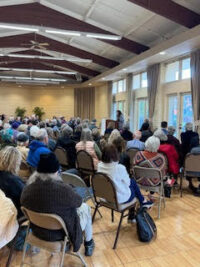Speakers urge council to take housing stand
Affordable housing and rent control featured prominently in the public comments at the May 7 city council meeting.
“If we are not a community that welcomes ALL its members by providing housing and health care and living wage,” said one speaker, “I really don’t think whether we have chickens or gardens matters in terms of our own morals and ethics.” “Prop 98 is a knife at the throat of society,” said another, urging the council to align itself with Prop 99, which protects homeowners.
Proposition 98, which will appear on the June 3 ballot, would limit the use of eminent domain and phase out rent control, while protecting those who live on fixed or limited incomes and remain in their homes.
Councilmember Stanley Cohen said, “The absentee ballots are out. I’ve got mine. If you’re up here, you understand the impact. It’s important that we stop 98 and pass 99.”
Sonoma-Aswan redux May 19
The Sister Cities relationship between Aswan, Egypt and Sonoma will take a step toward reality at 7 p.m., Monday, May 19, in the Community Meeting Room, 177 First St. W.
Last month’s visit by the Consul General of Egypt in San Francisco, Ambassador Abderahman Salaheldin, set in motion the idea of a relationship between two cities whose common interests include tourism, history, agriculture, educational enrichment, and telemedicine. Following that visit, the governor of Aswan asked Ambassador Salaheldin to formally propose a relationship between the two cities.
Egypt has the largest population of any country in Africa and in the Middle East. Its economy is undergoing a program of modernization. Aswan, the southern most city in Egypt, is located in a beautiful setting on the east bank of the Nile amidst many ancient and historic sites and influenced by the nearby Nubian culture. The nearby Aswan dam was constructed with the help of the Soviet Union in the 1950s and 1960s. Today Egypt is a stalwart ally of the United States in maintaining peace with Israel.
City Hall makeover bids sought
What a difference a month makes – especially when your hundredth birthday is at stake.
That difference was the topic of serious discussion at the May 7 Sonoma City Council meeting, as councilmembers and staff tried to juggle the bid process for renovating City Hall.
Built of basalt quarried from the hills behind Mountain Cemetery, the structure was dedicated September 9, 1908. Should the estimated $332,772 renovation proceed as planned – extensive cleaning, painting inside and out, and refinishing or remaking some interior spaces – the work would be completed a month after the official centenary celebration.
That didn’t sit well with Mayor Joanne Sanders, who said she’d rather hold September’s birthday party in a completed City Hall. Councilmember Ken Brown, who sits on the city’s Facilities Committee, said the group was comfortable with opening City Hall as a “work in progress” and pointed out that there’d be more room to celebrate before staff moved back in.
After some lively discussion regarding the state of the construction industry, the council voted 5–0 to have interested contractors submit two bids: one with an early October finish date, the second stipulating that City Hall be in “presentable shape” by Sept. 9.
Garden in every plot, chicken in every pot
While stories of rising costs of everything from gas to grain make headlines, one Sonoma citizen – dubbed the “last pioneer” by the author of his biography –has an answer: backyard gardens.
“Planting a garden brings families together,” said Bob Cannard in a letter personally delivered in the City Council meeting May 7. “It takes less water and expense to plant a garden than to keep a lawn.” To those who think the concept means heavy work and sparse reward, he added, “Twenty minutes a day on a plot 20 feet by 20 feet will supply 20 different vegetables on a year-round basis.”
Chickens, too. “Every person in Sonoma could keep three hens.” The catch here is that, in the city, it costs over $100 a year for a permit to keep livestock, and that is what Cannard wants the mayor to change. He said children can raise and sell their produce in neighborhood stands. “Neighborhood farm stands are a good way to distribute the surplus to those unable to grow their own,” he said. “Your leadership can make it happen.”
Mayor Joanne Sanders said when she was a child, her family, who is French, raised their food. “My family was pretty progressive, they had chickens, rabbits. I watched the whole thing,” she said with a smile that suggested that while parts of the experience may not have been for the faint of heart, it was overall one she appreciated. “In Sonoma we don’t want to make it prohibitive for folks to have a few chickens and raise vegetables,” she said. “We also want to look at our own vegetable garden.”
Cannard said he hopes the suggestion will appear on the council’s agenda soon.
City seeks graffiti solutions
How does Sonoma cope with a projected 400 percent increase in graffiti cleanup costs?
The answer: Financial ingenuity.
Mayor Joanne Sanders posed the question at the City Council’s May 7 meeting, and urged a creative solution before June’s midyear budget review. “It’s becoming a $50,000-a-year problem,” she said, adding that her Broadway business office gets “tagged weekly” and pointing out the blight’s drain on police and public works staff.
“It just comes down to work that they don’t have a chance to get done,” Sanders said.
After some discussion, councilmember Steve Barbose suggested the city might seek money from its own Community Development Agency. The CDA, comprising council members and the city manager, oversees blight removal and economic growth along the Broadway/Napa Street corridor and environs. City Manager Linda Kelly said her staff would look into it, adding that since some graffiti had been spotted on the city’s hillside water tanks she’d also look into possible water-revenue applications.
In 2004, the city’s total cleanup bill for graffiti and related vandalism was $4,000, contrasted with $8,000 since January of this year, Public Works Director Milenka Bates told the council. Although convict labor from the county work farm has been occasionally used to clean the city’s bike paths, Sonoma’s graffiti abatement relies largely on volunteer efforts – reimbursing property owners $100 per incident. One tagger was caught and successfully prosecuted earlier this year, netting the city a grand total of $125.
Chavoya thanks council for home
Sonoma Park Foreman Dave Chavoya might have known that he couldn’t applaud the City Council without the City Council wanting to applaud him.
Chavoya stood up during the council’s May 7 public-comment session to thank the councilmembers for his longtime rental of a small house at the six-acre, city-owned Sonoma Garden Park on Seventh Street East. He also praised his colleagues – many of whom were present for Mayor Joanne Sanders’ proclamation celebrating May 18-24 as National Public Works Week – for helping him move from “a 30-year residence in four hours,” and thanked various members of the city staff for accommodating him during recent health problems.
After Chavoya returned to his seat, amid loud and sustained applause the councilmembers took turns acclaiming him for his musicianship and for keeping Sonoma Plaza “the jewel in the city’s crown.”
“I’m only as good as my staff,” Chavoya replied, ”And my staff is terrific.”
Other actions:
Declared May 16, 2008 Bike To Work Day.
Proclaimed May 11-17 Affordable Housing Week.
Approved in concept a Community Development Agency loan of $92,000 to a First Street east restaurant.
Raised the cap on the city’s Façade Improvement Program from $1,000 to $2,500 and approved a second cap of $5,000 for newly classified “larger projects.”






